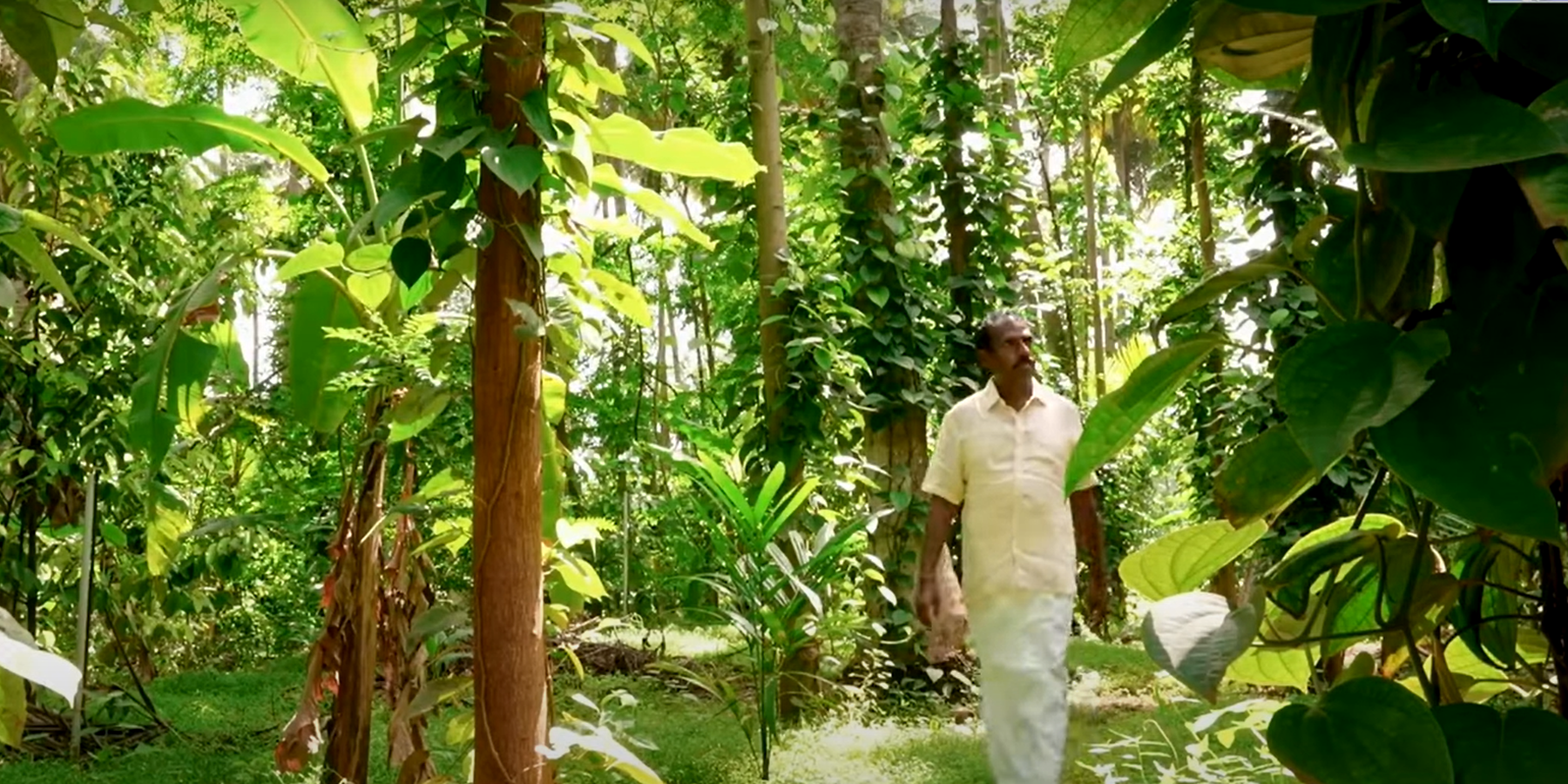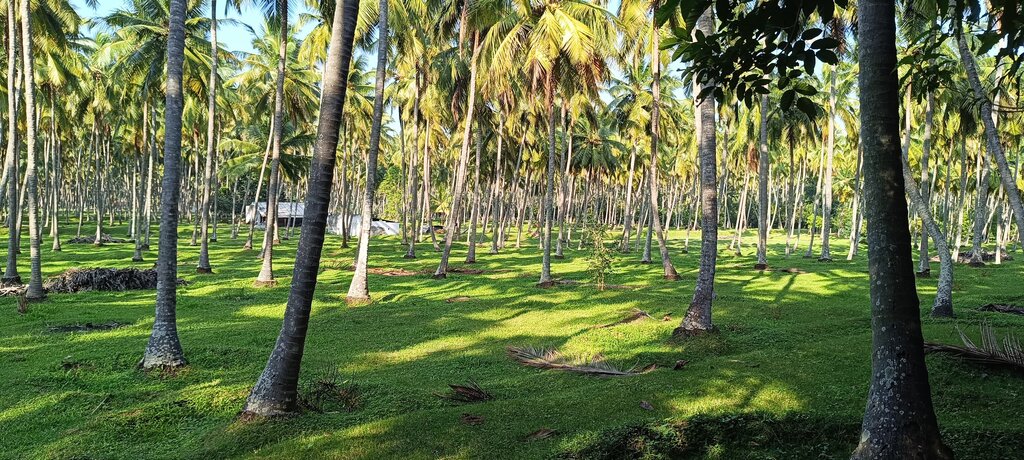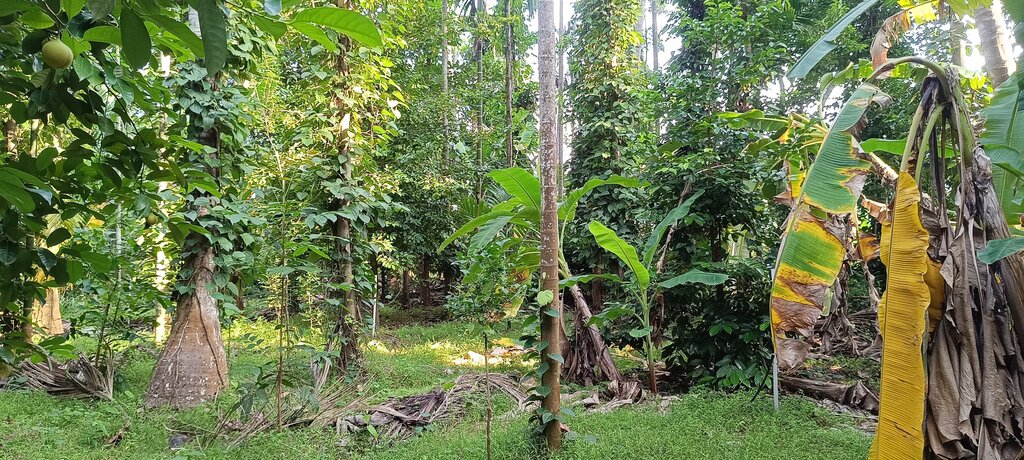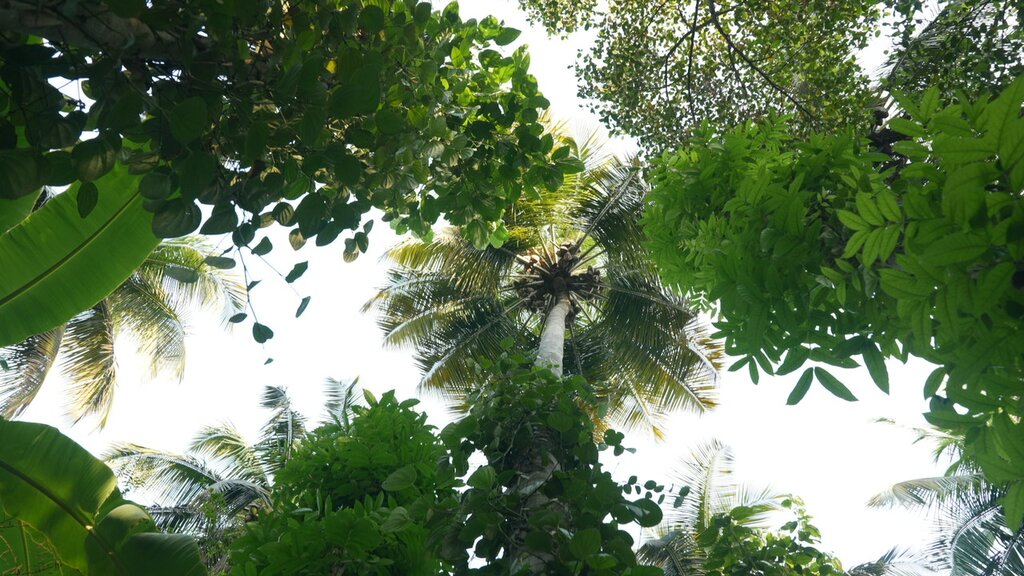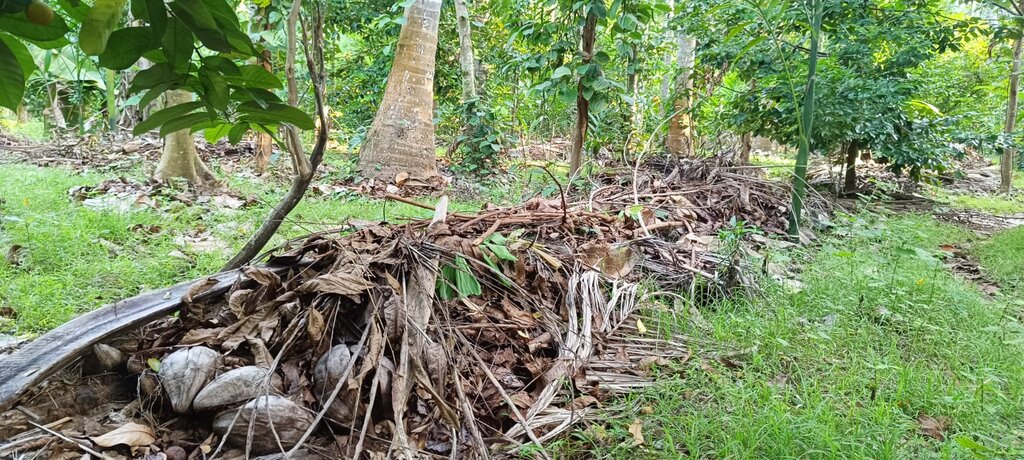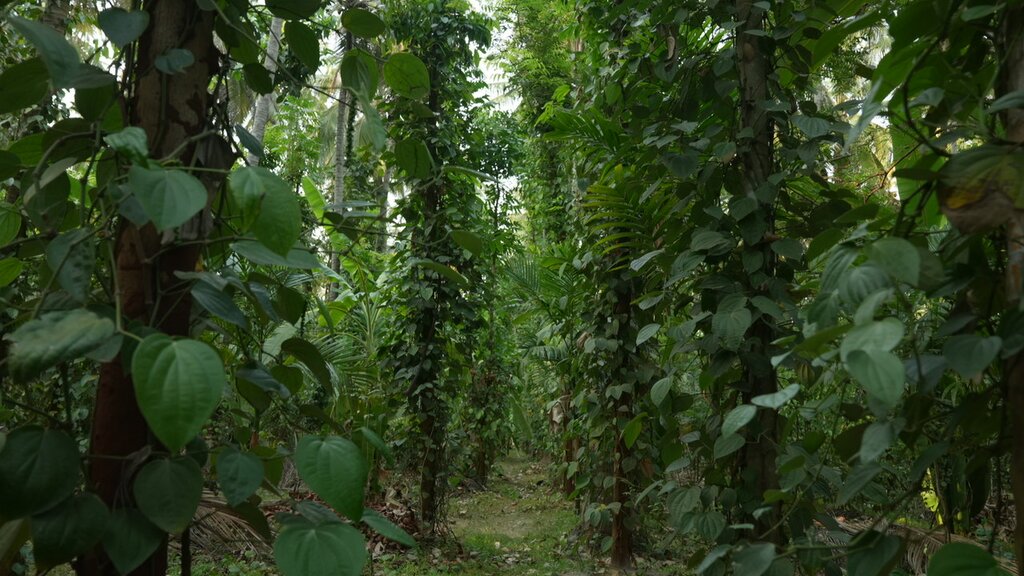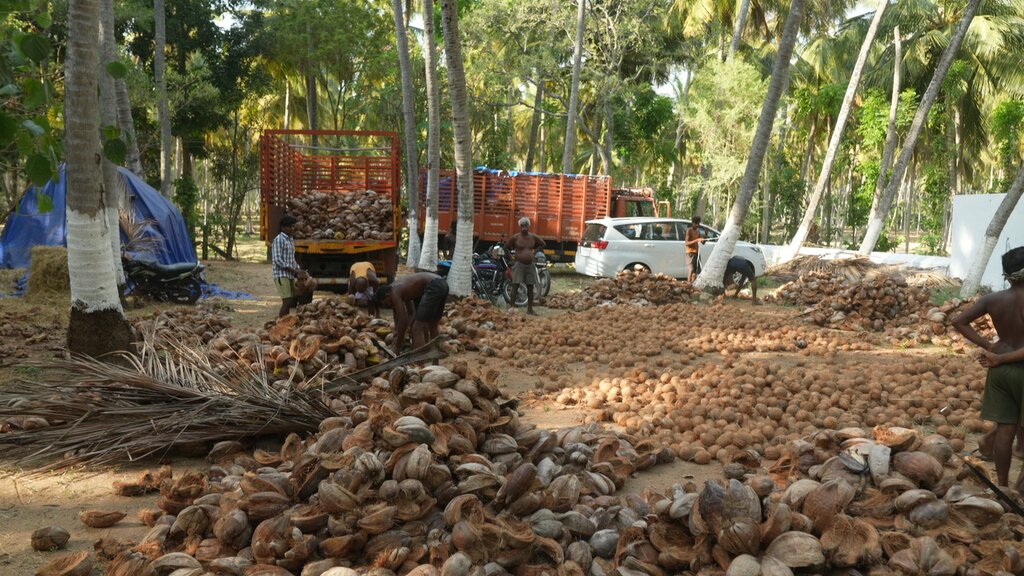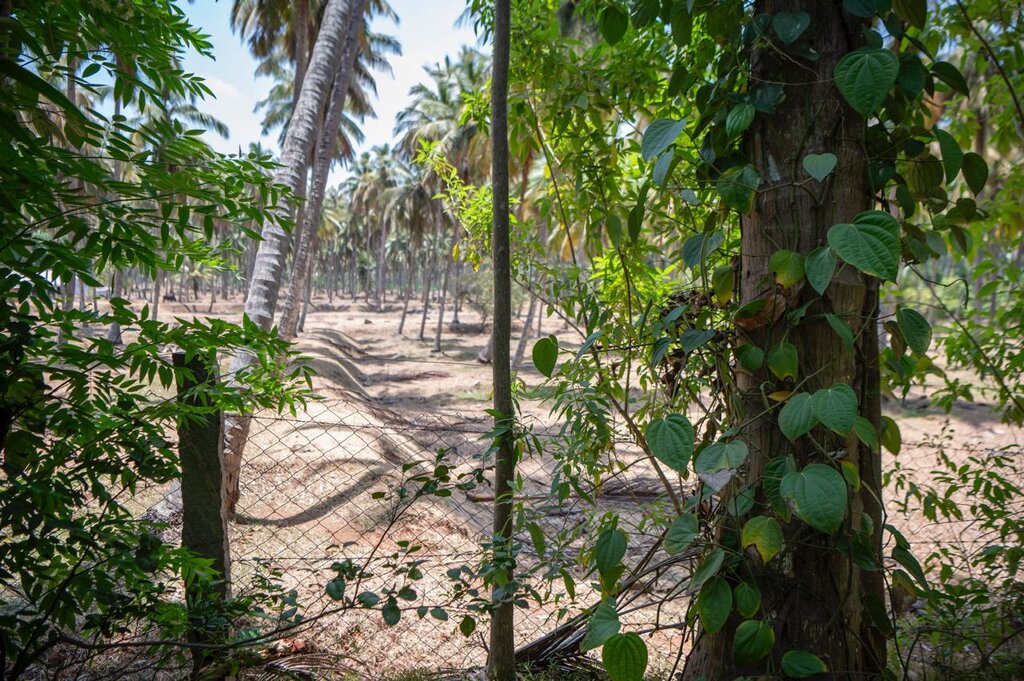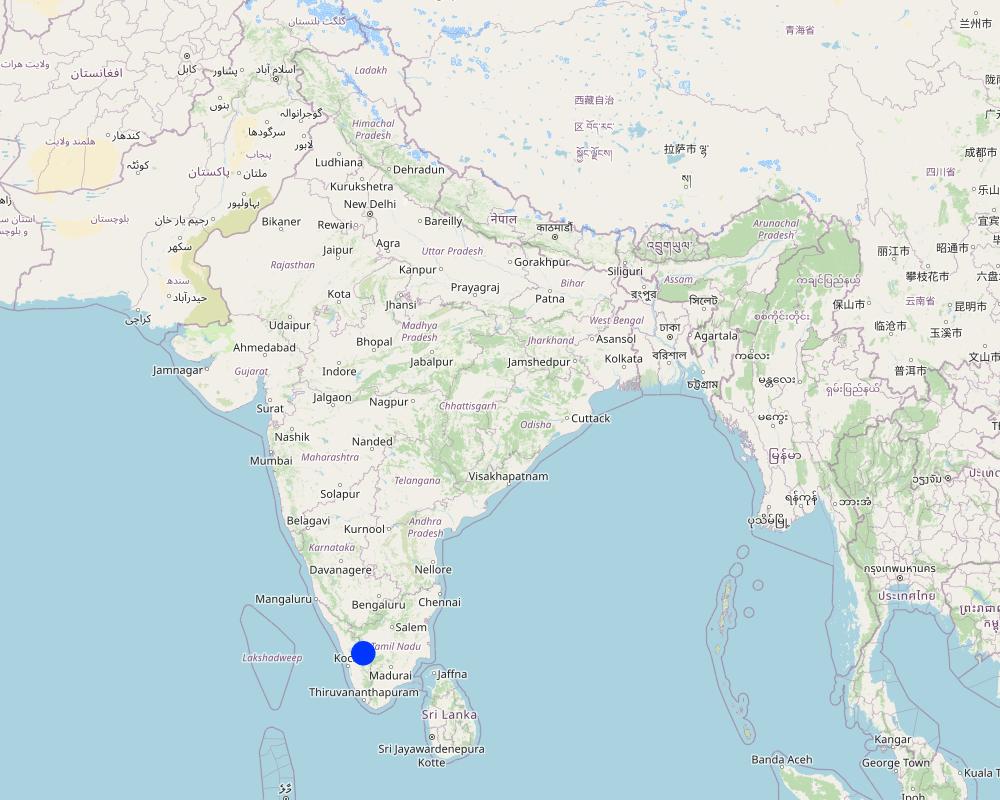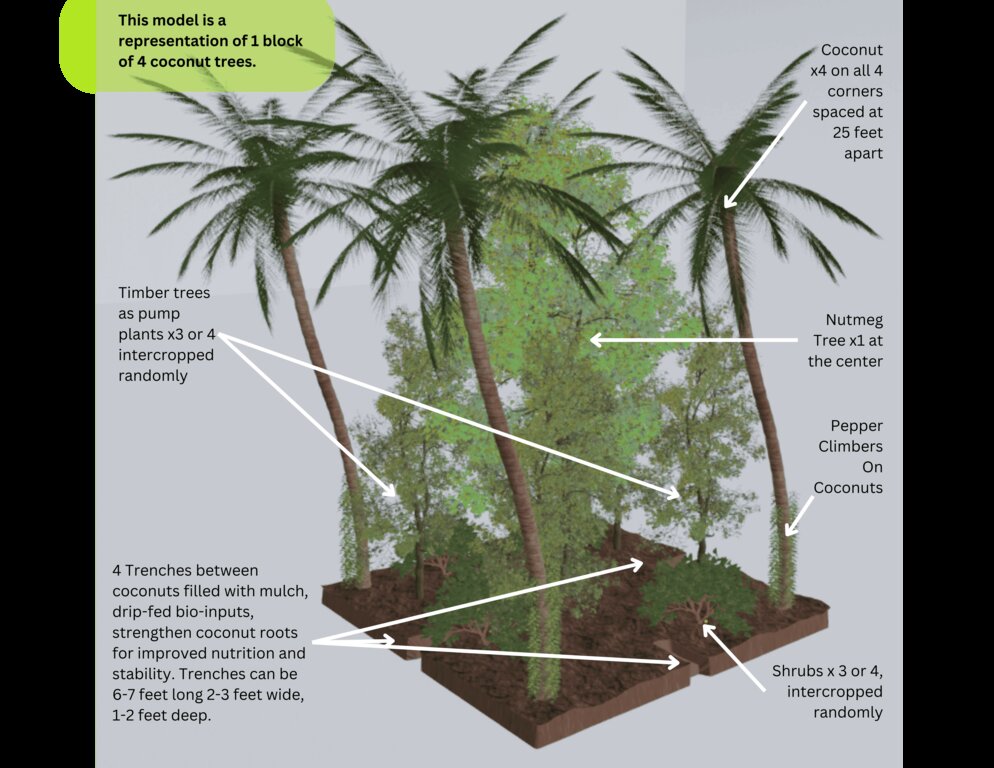Transforming a coconut monocrop into a multi-storey food forest [ប្រទេសឥណ្ឌា]
- ការបង្កើត៖
- បច្ចុប្បន្នភាព
- អ្នកចងក្រង៖ Praveena Sridhar
- អ្នកកែសម្រួល៖ Rushabh Desadla, Aditya Tated, Dhyana Balasubramanian, Vishwesh Singh, Lu Yu
- អ្នកត្រួតពិនិត្យច្រើនទៀត៖ William Critchley, Joana Eichenberger
Ottraipayir Thennai Sagubadi Muraiyai Pala Adukku Unavu Kaadaga Matruthal.
technologies_7366 - ប្រទេសឥណ្ឌា
ពិនិត្យមើលគ្រប់ផ្នែក
ពង្រីកមើលទាំងអស់ បង្រួមទាំងអស់1. ព័ត៌មានទូទៅ
1.2 ព័ត៌មានលម្អិតពីបុគ្គលសំខាន់ៗ និងស្ថាប័នដែលចូលរួមក្នុងការវាយតម្លៃ និងចងក្រងឯកសារនៃបច្ចេកទេស
អ្នកជំនាញឯកទេស SLM:
អ្នកជំនាញឯកទេស SLM:
ឈ្មោះគម្រោងដែលបានចងក្រងឯកសារ/ វាយតម្លៃលើបច្ចេកទេស (បើទាក់ទង)
Save Soil Movementឈ្មោះអង្គភាពមួយ (ច្រើន) ដែលបានចងក្រងឯកសារ/ វាយតម្លៃបច្ចេកទេស (បើទាក់ទង)
Conscious Planet - Save Soil (Save Soil)1.3 លក្ខខណ្ឌទាក់ទងទៅនឹងការប្រើប្រាស់ទិន្នន័យដែលបានចងក្រងតាមរយៈ វ៉ូខេត
អ្នកចងក្រង និង(បុគ្គលសំខាន់ៗ)យល់ព្រមទទួលយកនូវលក្ខខណ្ឌនានាទាក់ទងទៅនឹងការប្រើប្រាស់ទិន្នន័យដែលបានចងក្រងតាមរយៈវ៉ូខេត:
បាទ/ចា៎
1.4 សេចក្តីប្រកាសស្តីពីចីរភាពនៃការពណ៌នាពីបច្ចេកទេស
តើបច្ចេកទេសដែលបានពណ៌នានេះមានបញ្ហាដែលផ្តោតលើការធ្លាក់ចុះគុណភាពដី, បើដូច្នេះវាមិនអាចត្រូវបានប្រកាសថាជាបច្ចេកទេសនៃការគ្រប់គ្រងប្រកបដោយចីរភាពទេ?
ទេ
1.5 ការយោងទៅលើកម្រងបញ្ជីសំណួរ (មួយ ឬច្រើន) នៃវិធីសាស្ត្រផ្សព្វផ្សាយ SLM (ដែលបានចងក្រងដោយទស្សនៈពិភពលោកស្តីពីវិធីសាស្ត្រ និងបច្ចេកទេសងអភិរក្ស WOCAT)
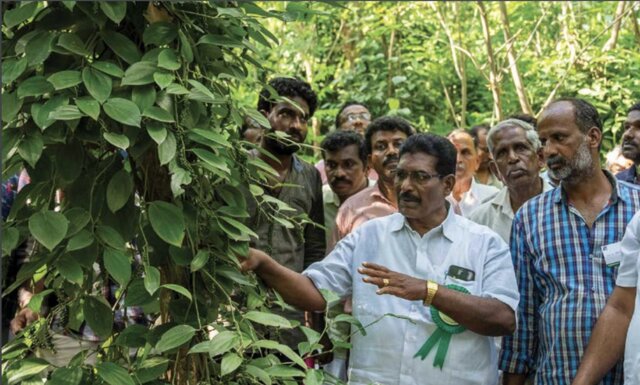
Conscious Planet - Save Soil’s Farmer Training and … [ប្រទេសឥណ្ឌា]
The approach focuses on supporting farmers to increase productivity by increasing soil biology and organic matter content, primarily through plant residue and animal waste. Awareness and advocacy are followed by training programs and support for adopting regenerative agricultural practices.
- អ្នកចងក្រង៖ Praveena Sridhar
2. ការពណ៌នាពីបច្ចេកទេស SLM
2.1 ការពណ៌នាដោយសង្ខេបពីបច្ចេកទេស
និយមន័យបច្ចេកទេស:
Transforming a monocrop coconut farm into a resilient food forest can sustainably enhance soil health, biodiversity and productivity while reducing labour and external input requirements. This demonstrates the potential to increase yields and provide long-term economic and ecological stability for farmers.
2.2 ការពណ៌នាលម្អិតពីបច្ចេកទេស
ការពណ៌នា:
Transforming a monocrop coconut farm into a resilient food forest can sustainably enhance soil health, biodiversity, and productivity while reducing labour and external input requirements. This demonstrates the potential to increase yields and provide long-term economic and ecological stability for farmers. Experience was gained from implementation in 2008 on a monocrop coconut farm in Pollachi, Tamil Nadu. The stages were as follows:
1) Rainwater management: Trenches were dug throughout the farm to retain rainwater and prevent runoff, thus enhancing soil moisture. This was critical given the limited rainfall in the region. A drip irrigation system was installed for efficient watering.
2) Plant diversity: Various crops were introduced. Nutmeg, intercropped among coconut trees, provides 3 - 4 times the income of coconuts after 15 to 20 years. Timber trees extract micronutrients from deeper soil layers via deep tap roots: micronutrients are concentrated in the leaves which are used as mulch to enrich the soil nutrient profile. Banana and papaya provided early income, shade for plants, and added biomass. This diversity also ensures a steady income, reducing dependency on external markets.
3) Biomass and soil fertility improvement: Fast-growing crops were planted to generate additional biomass. Leaves were pruned and added to the water-retaining trenches as mulch. Nitrogen-fixing plants were cultivated extensively to improve soil fertility, eliminating the need for chemical fertilizers.
4) Mulch and bio-input application: Mulch in the trenches was decomposed by the bio-inputs from Cows (Earlier 2, now 1) applied via drip lines, which increased soil organic matter through enhanced microbial decomposition. The irrigation and sprinklers were used judiciously to achieve soil moisture rather than over-watering, as trees primarily needed stable moisture conditions.
5) Minimal maintenance approach: After establishing this system, the farm required minimal maintenance. There was no need for tilling, weeding, or other intensive practices, just monitoring of, and maintaining, moisture levels. This low-maintenance approach reduces farmers’ workloads and improves their quality of life.
6) Enhanced biodiversity and pest management: To further enhance biodiversity, flowering plants to attract pollinators and predatory insects can be planted along the farm's boundaries - though this was not done at this particular site. Nonetheless, the increased biodiversity already fostered here brought in earthworms, birds, and beneficial insects for natural pest management.
After 12 years of minimal maintenance, soil organic matter content increased from 0.5% to 3.36%, and both production quantity and quality increased. The farm retained high soil moisture despite periods of low rainfall. Land users liked the use of minimal inputs, crop diversification as a financial safety net, and the visible impact on soil health and yield, as well as the increase in land value. There was initial fear about time and money invested and doubts about the feasibility of a technology that challenged the status quo of the region. Digging trenches and planting saplings were physically demanding. The initial pest pressure was also a concern before a stable ecosystem was established. The transformation of this coconut monoculture into a diverse food forest has demonstrated a sustainable model of enhanced resilience, productivity, and biodiversity. This model can be replicated across similar regions to help minimize labor and improve farmers’ livelihoods while restoring land and ecosystems.
2.3 រូបភាពនៃបច្ចេកទេស
2.4 វីដេអូនៃបច្ចេកទេស
ការពណ៌នាសង្ខេប:
With a few simple interventions, soil that was infertile was brought back to life.
YouTube video link: https://youtu.be/Pt4AEXzgTfc?feature=shared
កាលបរិច្ឆេទ:
10/06/2022
ទីតាំង:
Pollachi, Tamil Nadu
ឈ្មោះអ្នកថតវីឌីអូ:
Save Soil Media team
2.5 ប្រទេស/តំបន់/ទីតាំងកន្លែង ដែលបច្ចេកទេសត្រូវបានអនុវត្ត និងបានគ្រប់ដណ្តប់ដោយការវាយតម្លៃនេះ
ប្រទេស:
ប្រទេសឥណ្ឌា
តំបន់/រដ្ឋ/ខេត្ត:
Tamil Nadu
បញ្ជាក់បន្ថែមពីលក្ខណៈនៃទីតាំង:
Pollachi
បញ្ជាក់ពីការសាយភាយនៃបច្ចេកទេស:
- អនុវត្តនៅកន្លែងជាក់លាក់មួយ/ ប្រមូលផ្តុំនៅតំបន់តូចៗ
តើបច្ចេកទេស (មួយ ឬច្រើន) ទាំងនោះស្ថិតនៅក្នុងតំបន់ការពារជាអចិន្ត្រៃយ៍ណាមួយដែរឬទេ?
ទេ
Map
×2.6 កាលបរិច្ឆេទនៃការអនុវត្ត
ប្រសិនបើមិនច្បាស់ឆ្នាំ សូមបញ្ជាក់កាលបរិច្ឆេទដែលប្រហាក់ប្រហែល:
- 10-50 ឆ្នាំ
2.7 ការណែនាំពីបច្ចេកទេស
សូមបញ្ជាក់តើបច្ចេកទេសត្រូវបានណែនាំឱ្យអនុវត្តដោយរបៀបណា:
- តាមរយៈគម្រោង / អន្តរាគមន៍ពីខាងក្រៅ
មតិយោបល់ (ប្រភេទនៃគម្រោង ។ល។):
The key contributions to the project's technical knowledge include Ethirajalu R (Technical Expert), Anand Ethirajal (Operations Lead), and Dr. Poonyamurti (Ethnoveterinary Medicines Expert). Their expertise, along with the valuable insights shared by Indian stalwarts like Nammalwar, Sripad Davolkar, and Subhash Palekar
3. ចំណាត់ថ្នាក់នៃបច្ចេកទេស SLM
3.1 គោលបំណងចម្បង (១ ឬច្រើន) នៃបច្ចេកទេសនេះ
- ធ្វើឱ្យប្រសើរឡើងនូវផលិតកម្ម
- កាត់បន្ថយ, បង្ការ, ស្តារឡើងវិញនូវការធ្លាក់ចុះគុណភាពដី
- អភិរក្ស/ធ្វើឱ្យប្រសើរឡើងជីវចម្រុះ
- កាត់បន្ថយការប្រែប្រួលអាកាសធាតុ និងផលប៉ះពាល់របស់វា
- បង្កើតផលប្រយោជន៍សេដ្ឋកិច្ច
3.2 ប្រភេទដីប្រើប្រាស់មួយប្រភេទ (ច្រើនប្រភេទ) ដែលបានអនុវត្តបច្ចេកទេស
ដីប្រើប្រាស់ចម្រុះនៅលើដីតែមួយ:
បាទ/ចា៎
បញ្ជាក់ពីប្រភេទដីច្រើនប្រភេទ (ដីដាំដំណាំ/ដីចិញ្ចឹមសត្វ/ដីព្រៃឈើ):
- កសិរុក្ខកម្ម

ដីដាំដំណាំ
- ដំណាំរយៈពេលវែង (មិនមែនឈើ)
- ប្រភេទដើមឈើធំៗ និងដើមឈើតូចៗ
- Climbers : Pepper
ដំណាំរយៈពេលវែង (មិនមែនឈើ) - បញ្ជាក់ប្រភេទដំណាំ:
- ចេក/plantain/abaca
- រុក្ខជាតិឱសថ/ រុក្ខជាតិមានក្លិនក្រអូប/ រុក្ខជាតិការពារពីសត្វល្អិត - មានរយៈពេលវែង
- Curry Leaves, Lime, Turmeric, Papaya
ប្រភេទដើមឈើធំៗ និងដើមឈើតូចៗ - បញ្ជាក់ប្រភេទ:
- ដូង (ផ្លែដូង ស្រកីដូង ស្លឹកដូង ។ល។)
- Nutmeg, Mahogany, Mountain Neem, Kino, Red Sandalwood, Blackwood, White Teak, Iron Wood
ចំនួនសារដែលដាំដំណាំក្នុងមួយឆ្នាំ:
- 1
តើជាការអនុវត្តន៍ដំណាំចន្លោះ?
បាទ/ចា៎
តើជាការអនុវត្តន៍ដំណាំវិលជុំ?
ទេ
3.3 បន្ទាប់ពីអនុវត្តបច្ចេកទេស តើដីប្រើប្រាស់មានការប្រែប្រួលដែររឺទេ?
បន្ទាប់ពីអនុវត្តបច្ចេកទេស តើដីប្រើប្រាស់មានការប្រែប្រួលដែររឺទេ?
- បាទ/ច៎ា (សូមបំពេញសំណួរខាងក្រោមពីស្ថានភាពដីប្រើប្រាស់មុនពេលអនុវត្តបច្ចេកទេស)
ដីប្រើប្រាស់ចម្រុះនៅលើដីតែមួយ:
ទេ

ដីដាំដំណាំ
- ប្រភេទដើមឈើធំៗ និងដើមឈើតូចៗ
ប្រភេទដើមឈើធំៗ និងដើមឈើតូចៗ - បញ្ជាក់ប្រភេទ:
- ដូង (ផ្លែដូង ស្រកីដូង ស្លឹកដូង ។ល។)
តើជាការអនុវត្តន៍ដំណាំចន្លោះ?
ទេ
តើជាការអនុវត្តន៍ដំណាំវិលជុំ?
ទេ
3.4 ការផ្គត់ផ្គង់ទឹក
ការផ្គត់ផ្គង់ទឹកនៅកន្លែងអនុវត្តបច្ចេកទេស:
- ទឹកភ្លៀង និងប្រព័ន្ធស្រោចស្រព
3.5 ក្រុម SLM ដែលបច្ចេកទេសស្ថិតនៅក្នុង
- កសិរុក្ខកម្ម
- ធ្វើឱ្យប្រសើរឡើងគម្របដី/ ដំណាំគម្របដី
- ការគ្រប់គ្រងជីជាតិដីតាមបែបចម្រុះ
3.6 វិធានការ SLM ដែលបញ្ចូលនូវបច្ចេកទេស

វិធានការក្សេត្រសាស្ត្រ
- A1: ដំណាំ/គម្របដី
- A2: សារធាតុសរីរាង្គ/ជីជាតិដី
- A6: ការគ្រប់គ្រងកាកសំណល់
A6: បញ្ជាក់ពីការគ្រប់គ្រងកាកសំណល់:
A 6.4: រក្សាទុក

វិធានការរុក្ខជាតិ
- V1: ឈើធំៗ និងដើមឈើតូចៗ

វិធានការរចនាស័ម្ពន្ធ
- S2: ភ្លឺ ច្រាំង
- S4: កម្រិតភ្លឺ រណ្តៅ
- S6: ជញ្ជាំង, របាំង, របងឈើខ្ពស់ៗ
- S7: ការប្រមូលទឹកស្តុកទុក/ផ្គត់ផ្គង់ទឹក/ សម្ភារៈស្រោចស្រព
- S8: អនាម័យ/ទំនប់ទឹកកង្វក់
- S9: រោងដំណាំ និងរោងចិញ្ចឹមសត្វ
3.7 កំណត់ប្រភេទនៃការធ្លាក់ចុះគុណភាពដីសំខាន់ៗដែលបច្ចេកទេសនេះបានដោះស្រាយ

ការហូរច្រោះដីដោយសារទឹក
- Wt: ការបាត់ដីស្រទាប់លើដោយការហូរច្រោះ

ការបាត់ដីដោយសារខ្យល់
- Et: ការបាត់បង់ដីស្រទាប់លើ

ការធ្លាក់ចុះសារធាតុគីមីក្នុងដី
- Cn: ការថយចុះជីជាតិ និងកាត់បន្ថយបរិមាណសារធាតុសរីរាង្គ (មិនកើតឡើងដោយការហូរច្រោះទេ)
- Ca: អាស៊ីតកម្ម
- Cp: ការបំពុលដី
- Cs: សារធាតុប្រៃ/អាល់កាឡាំង

ការបាត់បង់រូបសាស្ត្រនៃដី
- Pc: ការហាប់ណែន

ការធ្លាក់ចុះជីវសាស្ត្រនៃដី
- Bc: ការថយចុះនូវគម្របរុក្ខជាតិ
- Bh: ការបាត់បង់ទីជំរក
- Bq: ការថយចុះនូវជីវម៉ាស/ បរិមាណ
- Bs: សមាសភាពដែលមានគុណភាពនិងប្រភេទសត្វ/ការថយចុះនូវជីវចម្រុះ
- Bl: ការបាត់បង់មីក្រូ និងម៉ាក្រូសរីរាង្គរបស់ដី
- Bp: ការកើនឡើងនូវសត្វល្អិត ឬជំងឺ បាត់បង់នូវសត្វមានប្រយោជន៍

ការបាត់បង់ទឹក
- Ha: ការថយចុះសំណើមដី
- Hs: ការប្រែប្រួលបរិមាណទឹកនៅលើផ្ទៃដី
- Hg: ការប្រែប្រួលបរិមាណទឹកនៅក្រោមដី
- Hq: ការថយចុះគុណភាពទឹកនៅក្រោមដី
3.8 ការពារ កាត់បន្ថយ ឬស្តារឡើងវិញនៃការធ្លាក់ចុះគុណភាពដី
បញ្ជាក់ពីគោលដៅរបស់បច្ចេកទេស ដែលផ្តោតទៅការធ្លាក់ចុះគុណភាពដី:
- ការជួសជុល/ ស្តារឡើងវិញនៃឱនភាពដីធ្ងន់ធ្ងរ
4. បច្ចេកទេសជាក់លាក់ សកម្មភាពអនុវត្ត ធាតុចូល និងថ្លៃដើម
4.1 គំនូសបច្ចេកទេសនៃបច្ចេកទេសនេះ
លក្ខណៈពិសេសនៃបច្ចេកទេស (ទាក់ទងនឺងគំនូរបច្ចេកទេស):
Area: 25 x 25 square feet.
Number of Coconut Trees: 4
Number of Nutmeg Trees: 1
Number of Pepper Climbers: 4
Number of Shrubs: 3-4 (Lime, Curry leaves, Medicinal herbs and Turmeric)
Number of Timber Trees : 3-4 (Mahogany, Mountain Neem, Kino, Red Sandalwood, Blackwood, White Teak and Ironwood)
Number of trenches : 4 ( 6x3x2 ft each, half in this block, half extended to the next block.
Irrigation System: Drip and a Center Fog Sprinkler for creating moisture in the atmosphere.
Input application: Cow dung and Cow urine mix flows to the trench covered with biomass. Decomposes it over time and creates humus for all the plants.
Initially biomass crops are planted, slowly transitioning to trees as the soil improves.
No maintenance after 3-4 years.
Coconut collected after it drops naturally.
Nutmeg and Pepper harvest happens in 3-4 years, gradually increasing yields.
Shrubs are harvested occasionally for self consumption and direct on farm sales.
ឈ្មោះអ្នកនិពន្ធ:
Aditya Tated
កាលបរិច្ឆេទ:
29/10/2024
4.2 ព័ត៌មានទូទៅដែលពាក់ព័ន្ធនឹងការគណនាធាតុចូល និងថ្លៃដើម
កំណត់របៀបនៃការគណនាថ្លៃដើម និងធាតុចូល:
- ក្នុងតំបន់អនុវត្តបច្ចេកទេស
កំណត់ទំហំ និងឯកត្តាផ្ទៃដី:
5.66 hectares
បើសិនប្រើឯកតាតាមតំបន់ សូមបញ្ជាក់តម្លៃបម្លែងវាទៅជាហិកតា (ឧ. 1 ហិកតា = 2.47 អា)៖ 1 ហិកតា =:
1hectare = 2.47 acres
ផ្សេងៗ/ រូបិយប័ណ្ណជាតិ (បញ្ជាក់):
INR
បើពាក់ព័ន្ធសូមកំណត់អត្រាប្តូរប្រាក់ពីដុល្លាទៅរូបិយប័ណ្ណតំបន់ (ឧ. 1 ដុល្លារ = 79.9 រៀលនៃរូបិយប័ណ្ណប្រេស៊ីល) ៖ 1 ដុល្លារ =:
84,07
កំណត់ថ្លៃឈ្នួលជាមធ្យមនៃការជួលកម្លាំងពលកម្មក្នុងមួយថ្ងៃ:
600 INR
4.3 សកម្មភាពបង្កើត
| សកម្មភាព | រយៈពេល (រដូវកាល) | |
|---|---|---|
| 1. | Plot assessment and planning | Before onset of rains |
| 2. | Digging trenches for rainwater harvesting | Before the rainy season |
| 3. | Setting up drip irrigation system | Before planting; dry season |
| 4. | Planting initial tree species (timber, fruit, nitrogen-fixing) | Early rainy season |
| 5. | Planting startup crops (e.g., banana, papaya) | Early rainy season |
| 6. | Mulching trenches with plant biomass | After trench creation, ongoing |
| 7. | Adding bio-inputs to mulch beds | Throughout growing seasons |
| 8. | Pruning trees and returning biomass | Regular intervals during dry seasons |
| 9. | Planting additional companion species | After initial species establishment |
| 10. | Setting up pest repellent measures | As needed, ongoing |
4.4 ថ្លៃដើម និងធាតុចូលដែលត្រូវការសម្រាប់ការបង្កើតបច្ចេកទេស
| បញ្ជាក់ពីធាតុចូល | ឯកតា | បរិមាណ | ថ្លៃដើមក្នុងមួយឯកតា | ថ្លៃធាតុចូលសរុប | % នៃថ្លៃដើមដែលចំណាយដោយអ្នកប្រើប្រាស់ដី | |
|---|---|---|---|---|---|---|
| កម្លាំងពលកម្ម | Trench Digging | machine-hours | 100,0 | 1000,0 | 100000,0 | 100,0 |
| កម្លាំងពលកម្ម | Tree Planting | person-days | 75,0 | 600,0 | 45000,0 | 100,0 |
| សម្ភារៈ | Farm Tools | lump sum | 1,0 | 20000,0 | 20000,0 | 100,0 |
| សម្ភារៈ | Irrigation Setup | lump sum | 1,0 | 100000,0 | 100000,0 | 100,0 |
| សម្ភារៈ | Pruning Machine | units | 1,0 | 25000,0 | 25000,0 | 100,0 |
| សម្ភារៈដាំដុះ | Timber Saplings | units | 5500,0 | 3,0 | 16500,0 | 100,0 |
| សម្ភារៈដាំដុះ | Nutmeg Saplings | units | 1000,0 | 20,0 | 20000,0 | 100,0 |
| សម្ភារៈដាំដុះ | Pepper Saplings | units | 1000,0 | 40,0 | 40000,0 | 100,0 |
| សម្ភារៈដាំដុះ | Fruit Trees | units | 500,0 | 100,0 | 50000,0 | 100,0 |
| ជី និងសារធាតុពុល | Organic Manure | load | 10,0 | 1500,0 | 15000,0 | 100,0 |
| ជី និងសារធាតុពុល | Organic Pest Repellants | lump sum | 1,0 | 20000,0 | 20000,0 | 100,0 |
| សម្ភារៈសាងសង់ | Fencing Irrigation | lump sum | 1,0 | 200000,0 | 200000,0 | 100,0 |
| សម្ភារៈសាងសង់ | Bio-Input Preparation Unit | lump sum | 1,0 | 200000,0 | 200000,0 | 100,0 |
| សម្ភារៈសាងសង់ | Pipes and Valves | lump sum | 1,0 | 530000,0 | 530000,0 | 100,0 |
| សម្ភារៈសាងសង់ | Tool Shed | lump sum | 1,0 | 50000,0 | 50000,0 | 100,0 |
| សម្ភារៈសាងសង់ | Worker Shed | lump sum | 1,0 | 50000,0 | 50000,0 | 100,0 |
| ផ្សេងៗ | Farm Animals | units | 5,0 | 20000,0 | 100000,0 | 100,0 |
| ផ្សេងៗ | Fodder | annual | 1,0 | 25000,0 | 25000,0 | 100,0 |
| ថ្លៃដើមសរុបក្នុងការបង្កើតបច្ចេកទេស | 1606500,0 | |||||
| ថ្លៃដើមសរុបក្នុងការបង្កើតបច្ចេកទេសគិតជាដុល្លារ | 19109,08 | |||||
មតិយោបល់:
Land user bore all costs
4.5 សកម្មភាពថែទាំ
| សកម្មភាព | ពេលវេលា/ ភាពញឹកញាប់ | |
|---|---|---|
| 1. | Pruning | Every 6 months |
| 2. | Irrigation system maintenance | Annually, before dry season |
| 3. | Mulching trenches | Twice a year, before onset of rains |
| 4. | Adding bio-inputs to mulch beds | Happens automatically with irrigation. |
| 5. | Harvesting fruits and biomass | As and when needed Coconut is collected after it falls by itself. |
| 6. | Replanting missing or damaged trees | Annually, before rainy season |
| 7. | Fencing and protection checks | Quarterly |
4.6 កំណត់ថ្លៃដើមសម្រាប់ការថែទាំ/ សកម្មភាពរបស់បច្ចេកទេស (ក្នុងរយៈពេលមួយឆ្នាំ)
| បញ្ជាក់ពីធាតុចូល | ឯកតា | បរិមាណ | ថ្លៃដើមក្នុងមួយឯកតា | ថ្លៃធាតុចូលសរុប | % នៃថ្លៃដើមដែលចំណាយដោយអ្នកប្រើប្រាស់ដី | |
|---|---|---|---|---|---|---|
| កម្លាំងពលកម្ម | Pruning, mulching, replanting | person-days | 100,0 | 600,0 | 60000,0 | 100,0 |
| កម្លាំងពលកម្ម | Harvesting | person-days | 300,0 | 600,0 | 180000,0 | 100,0 |
| សម្ភារៈ | Tools for pruning fencing checks | lump sum | 1,0 | 10000,0 | 10000,0 | 100,0 |
| សម្ភារៈ | Irrigation system maintenance | lump sum | 1,0 | 10000,0 | 10000,0 | 100,0 |
| សម្ភារៈ | Fencing maintenance | lump sum | 1,0 | 20000,0 | 20000,0 | 100,0 |
| សម្ភារៈដាំដុះ | Replacement seedlings | pieces | 50,0 | 30,0 | 1500,0 | 100,0 |
| ជី និងសារធាតុពុល | Preparing organic bio-inputs via irrigation system | lump sum | 1,0 | 5000,0 | 5000,0 | 100,0 |
| សម្ភារៈសាងសង់ | Fencing materials for repair | lump sum | 1,0 | 8000,0 | 8000,0 | 100,0 |
| ផ្សេងៗ | Cow Care and Fodder | kg | 5,0 | 5000,0 | 25000,0 | 100,0 |
| ថ្លៃដើមសរុបសម្រាប់ការថែទាំដំណាំតាមបច្ចេកទេស | 319500,0 | |||||
| ថ្លៃដើមសរុបសម្រាប់ការថែទាំដំណាំតាមបច្ចេកទេសគិតជាដុល្លារ | 3800,4 | |||||
មតិយោបល់:
Land users bore all costs
4.7 កត្តាសំខាន់បំផុតដែលមានឥទ្ធិពលដល់ការចំណាយ
ពណ៌នាពីកត្តាប៉ះពាល់ចម្បងៗទៅលើថ្លៃដើម:
No factors significantly affected costs.
5. លក្ខណៈបរិស្ថានធម្មជាតិ និងមនុស្ស
5.1 អាកាសធាតុ
បរិមាណទឹកភ្លៀងប្រចាំឆ្នាំ
- < 250 មម
- 251-500 មម
- 501-750 មម
- 751-1,000 មម
- 1,001-1,500 មម
- 1,501-2,000 មម
- 2,001-3,000 មម
- 3,001-4,000 មម
- > 4,000 មម
កំណត់បរិមាណទឹកភ្លៀង (បើដឹង) ជា មីលីម៉ែត្រ:
865,00
លក្ខណៈពិសេស/ មតិយោបល់លើរដូវភ្លៀង:
Rainfall Distribution and Seasonality: Monsoon Seasons: Rainfall peaks during the southwest monsoon (June to September) and the northeast monsoon (October to November). August, October, and November are the rainiest months, each with an average precipitation between 167 to 214 mm.
Dry Periods: The driest months are January to March, with very low rainfall, averaging between 5 to 35 mm per month.
បញ្ជាក់ឈ្មោះឯកសារយោងនៃស្ថានីយឧតុនិយម:
Coimbatore Metrological station, India Meteorological Department’s (IMD) network.
តំបន់កសិអាកាសធាតុ
- សើម
Generally warm, with an average annual temperature around 26–28°C (79–82°F). The hottest months tend to be March to May, where temperatures can reach up to 36–40°C (97–105°F), while the coolest months are December and January, with average daily temperatures ranging from 25–26°C (77–79°F)
5.2 សណ្ឋានដី
ជម្រាលជាមធ្យម:
- រាបស្មើ (0-2%)
- ជម្រាលតិចតួច (3-5%)
- មធ្យម (6-10%)
- ជម្រាលខ្ពស់បន្តិច (11-15%)
- ទីទួល (16-30%)
- ទីទួលចោត (31-60%)
- ទីទួលចោតខ្លាំង (>60%)
ទម្រង់ដី:
- ខ្ពង់រាប
- កំពូលភ្នំ
- ជម្រាលភ្នំ
- ជម្រាលទួល
- ជម្រាលជើងភ្នំ
- បាតជ្រលងភ្នំ
តំបន់តាមរយៈកម្ពស់ :
- 0-100 ម
- 101-500 ម
- 501-1,000 ម
- 1,001-1,500 ម
- 1,501-2,000 ម
- 2,001-2,500 ម
- 2,501-3,000 ម
- 3,001-4,000 ម
- > 4,000 ម
បញ្ជាក់ថាតើបច្ចេកទេសនេះត្រូវបានអនុវត្តន៍នៅក្នុង:
- មិនពាក់ព័ន្ធទាំងអស់
5.3 ដី
ជម្រៅដីជាមធ្យម:
- រាក់ខ្លាំង (0-20 សម)
- រាក់ (21-50 សម)
- មធ្យម (51-80 សម)
- ជ្រៅ (81-120 សម)
- ជ្រៅខ្លាំង (> 120 សម)
វាយនភាពដី (ស្រទាប់លើ):
- ម៉ត់/ ធ្ងន់ (ឥដ្ឋ)
វាយនភាពដី (> 20 សម ស្រទាប់ក្នុង):
- ម៉ត់/ ធ្ងន់ (ឥដ្ឋ)
សារធាតុសរីរាង្គនៅស្រទាប់ដីខាងលើ:
- ទាប (<1%)
បើអាចសូមភ្ជាប់ការពណ៌នាពីដីឱ្យបានច្បាស់ ឬព័ត៌មានដែលអាចទទួលបាន ឧ. ប្រភេទដី, pH ដី/ ជាតិអាស៊ីត, សមត្ថភាពផ្លាស់ប្តូរកាចុង, វត្តមាននីត្រូសែន, ភាពប្រៃ ។ល។:
Soil type - Red sandy soil
5.4 ទឹកដែលអាចទាញមកប្រើប្រាស់បាន និងគុណភាពទឹក
នីវ៉ូទឹកក្រោមដី:
5-50 ម
ទឹកលើដីដែលអាចទាញយកប្រើប្រាស់បាន:
មិនមាន/ គ្មាន
គុណភាពទឹក (មិនបានធ្វើប្រត្តិកម្ម):
ទឹកពិសារដែលមានគុណភាពល្អ
គុណភាពទឹក គឺផ្តោតទៅលើ៖:
ទឹកក្រោមដី
តើមានបញ្ហាភាពទឹកប្រៃហូរចូលមកដែរឬទេ?
ទេ
តើទឹកជំនន់កំពុងកើតមាននៅតំបន់នេះដែររឺទេ?
ទេ
មតិយោបល់ និងលក្ខណៈពិសេសផ្សេងៗទៀតលើគុណភាព និងបរិមាណទឹក :
Pollachi, the place where the farm is located, water quality fluctuates throughout the year, particularly due to agricultural runoff and effluents from nearby industrial activities.
5.5 ជីវៈចម្រុះ
ភាពសម្បូរបែបនៃប្រភេទ:
- ទាប
ភាពសម្បូរបែបនៃទីជម្រក:
- ទាប
5.6 លក្ខណៈនៃអ្នកប្រើប្រាស់ដីដែលអនុវត្តបច្ចេកទេស
នៅមួយកន្លែង ឬពនេចរ :
- នៅមួយកន្លែង
ទីផ្សារនៃប្រព័ន្ធផលិតកម្ម:
- ពាក់កណ្តាលពាណិជ្ជកម្ម (ផ្គត់ផ្គង់ខ្លួនឯង/ ពាណិជ្ជកម្ម)
ចំណូលក្រៅកសិកម្ម:
- ច្រើនជាង 50% នៃចំណូល
កម្រិតជីវភាព:
- មធ្យម
ឯកជន ឬក្រុម:
- ធ្វើខ្លួនឯង/ គ្រួសារ
កម្រិតប្រើប្រាស់គ្រឿងយន្ត:
- គ្រឿងយន្ត/ ម៉ាស៊ីន
យេនឌ័រ:
- ស្ត្រី
- បុរស
អាយុរបស់អ្នកប្រើប្រាស់ដី:
- វ័យកណ្តាល
5.7 ទំហំផ្ទៃដីជាមធ្យមនៃដីប្រើប្រាស់ដោយអ្នកប្រើប្រាស់ដី ក្នុងការអនុវត្តបច្ចេកទេស
- < 0.5 ហិកតា
- 0.5-1 ហិកតា
- 1-2 ហិកតា
- 2-5 ហិកតា
- 5-15 ហិកតា
- 15-50 ហិកតា
- 50-100 ហិកតា
- 100-500 ហិកតា
- 500-1,000 ហិកតា
- 1,000-10,000 ហិកតា
- > 10,000 ហិកតា
តើផ្ទៃដីនេះចាត់ទុកជាទំហំកម្រិតណាដែរ ខ្នាតតូច មធ្យម ឬខ្នាតធំ (ធៀបនឹងបរិបទតំបន់)?
- ខ្នាតមធ្យម
5.8 ភាពជាម្ចាស់ដី កម្មសិទ្ធប្រើប្រាស់ដី និងកម្មសិទ្ធប្រើប្រាស់ទឹក
ភាពជាម្ចាស់ដី:
- ឯកជន មានកម្មសិទ្ធ
កម្មសិទ្ធិប្រើប្រាស់ដី:
- ឯកជន
កម្មសិទ្ធប្រើប្រាស់ទឹក:
- ឯកជន
តើកម្មសិទ្ធប្រើប្រាស់ដី គឺផ្អែកលើប្រព័ន្ធច្បាប់បែបបុរាណ?
បាទ/ចា៎
សូមបញ្ជាក់:
Private Ownership
5.9 ការប្រើប្រាស់សេវាកម្ម និងហេដ្ឋារចនាសម្ព័ន្ធ
សុខភាព:
- មិនល្អ
- មធ្យម
- ល្អ
ការអប់រំ:
- មិនល្អ
- មធ្យម
- ល្អ
ជំនួយបច្ចេកទេស:
- មិនល្អ
- មធ្យម
- ល្អ
ការងារ (ឧ. ការងារក្រៅកសិដ្ឋាន):
- មិនល្អ
- មធ្យម
- ល្អ
ទីផ្សារ:
- មិនល្អ
- មធ្យម
- ល្អ
ថាមពល:
- មិនល្អ
- មធ្យម
- ល្អ
ផ្លូវ និងការដឹកជញ្ជូន:
- មិនល្អ
- មធ្យម
- ល្អ
ទឹកផឹក និងអនាម័យ:
- មិនល្អ
- មធ្យម
- ល្អ
សេវាកម្មហិរញ្ញវត្ថុ:
- មិនល្អ
- មធ្យម
- ល្អ
6. ផលប៉ះពាល់ និងការសន្និដ្ឋាន
6.1 ផលប៉ះពាល់ក្នុងបរិវេណអនុវត្តបច្ចេកទេសដែលកើតមាន
ផលប៉ះពាល់លើសេដ្ឋកិច្ចសង្គម
ផលិតផល
ផលិតកម្មដំណាំ
គុណភាពមុន SLM:
110
គុណភាពក្រោយ SLM:
160
មតិយោបល់/ ការបញ្ជាក់:
Coconuts were small in size and fewer in number when the farm was bought. After 6-7 years, the counts increased from 110 per tree per year to 160 and size increased 150% on average.
គុណភាពដំណាំ
គុណភាពមុន SLM:
Not so tasty
គុណភាពក្រោយ SLM:
Taste is the best compared to surrounding many farms.
ហានិភ័យនៃភាពបរាជ័យរបស់ផលិតកម្ម
គុណភាពមុន SLM:
50-60%
គុណភាពក្រោយ SLM:
0%
មតិយោបល់/ ការបញ្ជាក់:
The risk of production failure has come down to 0% as there is no pest and disease attack. The coconuts yield continuously throughout the year.
ភាពសម្បូរបែបនៃផលិតផល
គុណភាពមុន SLM:
1
គុណភាពក្រោយ SLM:
3
មតិយោបល់/ ការបញ្ជាក់:
From just one crop to 2 main crops, pepper as a sub-main crop and a variety of fruits for self consumption.
ផ្ទៃដីផលិតកម្ម
គុណភាពមុន SLM:
40%
គុណភាពក្រោយ SLM:
60%
មតិយោបល់/ ការបញ្ជាក់:
Coconuts occupied approximately 40% area in terms of canopy. Now in addition to that there is nutmeg which occupies another 20%. Rest of the area is for timber and other supporting crops not included here.
ការគ្រប់គ្រងដី
គុណភាពមុន SLM:
24/7
គុណភាពក្រោយ SLM:
1 Day a Week
មតិយោបល់/ ការបញ្ជាក់:
Farmer before this owner spent hours in weeding, application of inputs and pesticide, burning of crop residue, harvesting coconuts. Now the whole farm needs 2 labour to collect fallen coconuts and turn on the irrigation switches and valves. The farmer comes to visit the farm once a week for monitoring.
ទឹកដែលអាចទាញមកប្រើប្រាស់បាន និងគុណភាពទឹក
គុណភាពទឹកបរិភោគ
ទឹកប្រើប្រាស់សម្រាប់ស្រោចស្រព
មតិយោបល់/ ការបញ្ជាក់:
Earlier the bore wells would run only for a couple of hours and then the water would dry out. Now it fulfills the irrigation requirement without interruption.
តម្រូវការទឹកសម្រាប់ស្រោចស្រព
មតិយោបល់/ ការបញ្ជាក់:
Demand for water has drastically come down as the SOC content in the soil has risen.
ចំណូល និងថ្លៃដើម
ការចំណាយលើធាតុចូលកសិកម្ម
មតិយោបល់/ ការបញ្ជាក់:
There is no expense in any agricultural input apart from maintenance of 2-3 cows. The entire system is automatic. The slurry from the cowshed goes into the tank which supplies input through a venturi to the drip irrigaton system.
ចំណូលក្នុងកសិដ្ឋាន
មតិយោបល់/ ការបញ្ជាក់:
Farm income has gone up significantly owing to the high yields, multiple crops, better prices, low cultivation and management costs.
ភាពសម្បូរបែបប្រភពប្រាក់ចំណូល
មតិយោបល់/ ការបញ្ជាក់:
Incomes are coming from sale of coconuts, nutmeg and pepper. Coconut oil is also extracted now by the farmer and sold at a high premium price.
បន្ទុកការងារ
មតិយោបល់/ ការបញ្ជាក់:
The drudgery of mainting a monocrop and all the works associalted with conventional agriculture is eliminated by 95%. The only workload is to pick up the fallen coconuts and harvest nutmeg and pepper.
ផលប៉ះពាល់ទៅលើវប្បធម៌សង្គម
ស្ថានភាពសុខភាព
មតិយោបល់/ ការបញ្ជាក់:
The health of the owner and the consumers is greatly benefitted owing to the absense of harmful chemicals and pesticides in the produce.
ចំណេះដឹង SLM / ការធ្លាក់ចុះគុណភាពដី
មតិយោបល់/ ការបញ្ជាក់:
This model is a great source of wisdom about tree-based regenerative agriculture which can counter land degradation. It has all the necessary components of how to convert dirt into soil.
ផលប៉ះពាល់ទៅលើអេកូឡូស៊ី
វដ្តទឹក/លំហូរ
គុណភាពទឹក
ការប្រមូលស្តុកទុកទឹក
លំហូរទឹកលើផ្ទៃដី
ប្រព័ន្ធបង្ហូរទឹក
នីវ៉ូទឹកក្រោមដី/ ដង្ហើមទឹក
រំហួត
ដី
សំណើមដី
មតិយោបល់/ ការបញ្ជាក់:
Soil moisture is maintained as high levels except for summers when its a little low due to the intense heat this region faces.
គម្របដី
ដីហាប់
មតិយោបល់/ ការបញ្ជាក់:
Soil compaction has reduced because of the heavy penetraton of tree roots, improved SOC and biological activity in the soil.
វដ្តនៃសារធាតុចិញ្ចឹម/ការទទួលបាន
មតិយោបល់/ ការបញ្ជាក់:
It is evident from the yields that there is a very resilient process of nutrient cycling happening in the farm compared to what was happening earlier.
សារធាតុសរីរាង្គដី/ការបូនក្រោមដី
គុណភាពមុន SLM:
0.5
គុណភាពក្រោយ SLM:
3.36
មតិយោបល់/ ការបញ្ជាក់:
The SOC level have increased continously and is still increasing because of the leaf litter that is added continuously throughout the year.
ជីវចម្រុះ៖ ដំណាំ, សត្វ
ដំណាំគម្រប
គុណភាពមុន SLM:
40%
គុណភាពក្រោយ SLM:
90%
មតិយោបល់/ ការបញ្ជាក់:
Vegetation cover in the form of trees, shrubs, perennial crops and pepper has shown dramatic increase.
ជីវម៉ាស/ កាបូនលើដី
មតិយោបល់/ ការបញ្ជាក់:
Addition of 3 times the number of trees has increased the above ground biomass multiple times.
ភាពសម្បូរបែបនៃរុក្ខជាតិ
មតិយោបល់/ ការបញ្ជាក់:
The farm is now a home for more than 100 species of plants compared to just one when it was bought.
ប្រភេទរាតត្បាត
មតិយោបល់/ ការបញ្ជាក់:
There is an absolute balance in the farm ecosystem with no species going out of control. There are no significant weeds as the soil ecosystem and shade doesn't support the common invasive species found in the region.
ភាពសម្បូរបែបនៃសត្វ
មតិយោបល់/ ការបញ្ជាក់:
Minor farm animals are seen. Since its not a large area, enough diversity has not been established.
ប្រភេទសត្វមានប្រយោជន៍
មតិយោបល់/ ការបញ្ជាក់:
There are no harmful species for which the farmer needs to worry about. All species are beneficaial in some way or the other.
ភាពសម្បូរបែបនៃទីជំរក
មតិយោបល់/ ការបញ្ជាក់:
Multi layer multi crop system allows various different habitat for a variety of species. Here from high coconut to rich soil undergrond has a habitat diversity of semi-forest which was not present earlier.
ការគ្រប់គ្រងកត្តាចង្រៃ/ ជំងឺ
មតិយោបល់/ ការបញ្ជាក់:
The farmer says he doesn't know what are pests now which was not the case earlier. Earlier his coconuts would be continously be harmed by something or the other.
ការកាត់បន្ថយហានិភ័យនៃគ្រោះមហន្តរាយ និងគ្រោះអាកាសធាតុ
ផលប៉ះពាល់នៃគ្រោះរាំងស្ងួត
មតិយោបល់/ ការបញ្ជាក់:
The impact of drought is not significant in this farm because of the green cover, soil moisture, high water tables, year-round water availability and overall resiliance of the system. All other conventional farms face enormous hardship during droughts.
ផលប៉ះពាល់នៃព្យុះស៊ីក្លូន/ព្យុះភ្លៀង
មតិយោបល់/ ការបញ្ជាក់:
Impact of rain storms is also less as there is enough wind barriers because of the dense vegetation. The coconots have penetrated their roots towards the trenches and underground in search of nutrients making them strongly grounded and able to withstand storms easily.
ការបំភាយនៃកាបូន និងឧស្ម័នផ្ទះកញ្ចក់
មតិយោបល់/ ការបញ្ជាក់:
This system is carbon negative as there is no use of chemicals or fossil fuels needed to run any operation except the transportation of coconuts to the markets.
ល្បឿនខ្យល់
មតិយោបល់/ ការបញ្ជាក់:
Wind velocity is hindered now due to the dense vegetation.
អាកាសធាតុ
មតិយោបល់/ ការបញ្ជាក់:
The micro-climate is the most tangible change that anyone visiting the farm is able to relish. The coolness inside the farm is completely mood-changing for someone who is entering from outside. It leaves people wanting to live here or create such a place for themselves. Its an oasis in a desert.
បញ្ជាក់ពីការប៉ាន់ស្មាននៃផលប៉ះពាល់ក្នុងបរិវេណអនុវត្តបច្ចេកទេស (វាស់វែង):
Soil Fertility: Initially, the soil was likely low in organic matter due to monoculture practices. Through the addition of nitrogen-fixing plants and mulching with biomass, the soil's nutrient levels improved naturally, eliminating the need for chemical fertilizers.
Soil Organic Carbon: Soil organic carbon increased notably from 0.5% to 3.36% due to continuous mulching, the addition of bio-inputs, and water-retaining trenches. These practices enriched the soil with organic matter, improving its structure and capacity to hold moisture.
Erosion Control and Water Retention: Trenches and rainwater harvesting reduced runoff, preventing soil erosion and enhancing water retention, which helped maintain stable soil moisture levels, even in dry periods.
Microbial Health: The use of bio-inputs via drip irrigation boosted microbial activity in the soil, accelerating the decomposition of organic matter into humus, which further improved soil fertility and structure.
6.2 ផលប៉ះពាល់ក្រៅបរិវេណអនុវត្តបច្ចេកទេសដែលកើតមាន
ទឹកដែលអាចទាញមកប្រើប្រាស់បាន
មតិយោបល់/ ការបញ្ជាក់:
It is assumed that as the groundwater table in the site has increased, it would definitely have some effect of the neighboring sites.
វាយតម្លៃផលប៉ះពាល់ក្រៅបរិវេណអនុវត្តបច្ចេកទេស (វាស់វែង):
We have not conducted measurement of off-site ecological impacts for this farm as of now.
6.3 ភាពប្រឈម និងភាពរួសនៃបច្ចេកទេសទៅនឹងការប្រែប្រួលអាកាសធាតុ និងគ្រោះអាកាសធាតុ/ គ្រោះមហន្តរាយ (ដែលដឹងដោយអ្នកប្រើប្រាស់ដី)
ការប្រែប្រួលអាកាសធាតុ
ការប្រែប្រួលអាកាសធាតុ
| រដូវកាល | កើនឡើង ឬថយចុះ | លក្ខណៈឆ្លើយតបនៃបច្ចេកទេសទៅនឹងការប្រែប្រួលអាកាសធាតុ | |
|---|---|---|---|
| សីតុណ្ហភាពប្រចាំឆ្នាំ | កើនឡើង | ល្អណាស់ | |
| សីតុណ្ហភាពប្រចាំរដូវកាល | រដូវប្រាំង | កើនឡើង | ល្អ |
| បរិមាណទឹកភ្លៀងប្រចាំឆ្នាំ | ល្អណាស់ | ||
| បរិមាណទឹកភ្លៀងប្រចាំរដូវកាល | សើម/រដូវភ្លៀង | កើនឡើង | ល្អណាស់ |
គ្រោះអាកាសធាតុ (មហន្តរាយ)
គ្រោះមហន្តរាយធម្មជាតិ
| លក្ខណៈឆ្លើយតបនៃបច្ចេកទេសទៅនឹងការប្រែប្រួលអាកាសធាតុ | |
|---|---|
| ព្យុះភ្លៀងតាមតំបន់ | ល្អណាស់ |
គ្រោះមហន្តរាយអាកាសធាតុ
| លក្ខណៈឆ្លើយតបនៃបច្ចេកទេសទៅនឹងការប្រែប្រួលអាកាសធាតុ | |
|---|---|
| រលកកម្តៅ | ល្អ |
| រាំងស្ងួត | ល្អ |
គ្រោះមហន្តរាយជីវៈសាស្ត្រ
| លក្ខណៈឆ្លើយតបនៃបច្ចេកទេសទៅនឹងការប្រែប្រួលអាកាសធាតុ | |
|---|---|
| ការមានបញ្ហាសត្វល្អិត/ដង្កូវ | ល្អណាស់ |
6.4 ការវិភាគថ្លៃដើម និងអត្ថប្រយោជន៍
តើផលចំណេញ និងថ្លៃដើមត្រូវបានប្រៀបធៀបគ្នាយ៉ាងដូចម្តេច (ទស្សនៈរបស់អ្នកប្រើប្រាស់ដី)?
រយៈពេលខ្លី:
អវិជ្ជមានតិចតួច
រយៈពេលវែង:
វិជ្ជមានខ្លាំង
តើផលចំណេញ និងការថែទាំ/ ជួសជុលត្រូវបានប្រៀបធៀបគ្នាយ៉ាងដូចម្តេច (ទស្សនៈរបស់អ្នកប្រើប្រាស់ដី)?
រយៈពេលខ្លី:
ប៉ះពាល់តិចតួចបំផុត
រយៈពេលវែង:
វិជ្ជមានខ្លាំង
6.5 ការទទួលយកបច្ចេកទេស
- 1-10%
ក្នុងចំណោមគ្រួសារទាំងអស់ដែលបានអនុវត្តបច្ចេកទេស តើមានប៉ុន្មានគ្រួសារដែលចង់ធ្វើដោយខ្លួនឯង ដោយមិនទទួលបានសម្ភារៈលើកទឹកចិត្ត/ប្រាក់ឧបត្ថម្ភ?:
- 0-10%
6.6 ការបន្សុំា
តើថ្មីៗនេះ បច្ចេកទេសនេះត្រូវបានកែតម្រូវដើម្បីបន្ស៊ាំទៅនឹងស្ថានភាពប្រែប្រួលដែរឬទេ?
ទេ
6.7 ភាពខ្លាំង/ គុណសម្បត្តិ/ ឱកាសនៃបច្ចេកទេស
| ភាពខ្លាំង/ គុណសម្បត្តិ/ ឱកាសនៅកន្លែងរបស់អ្នកប្រើប្រាស់ដី |
|---|
| 1) Efficient Rainwater Harvesting: Trenches prevent water runoff and retain moisture, helping farmers adapt to water-scarce conditions. Drip irrigation ensures efficient water use, reducing waste and improving moisture availability at plant roots. |
| 2) Nitrogen-fixing plants and bio-inputs build natural soil fertility, reducing or eliminating the need for chemical fertilizers. |
| 3) Income Stability: Diverse crops (timber, fruit, and cash crops like bananas and papayas) ensure year-round income and minimize dependency on a single crop. |
| 4) Pest and Disease Management: The natural ecosystem with pollinators and predatory insects reduces pest issues without needing chemical pesticides. |
| 5) Minimal Labor: Once established, the system requires less labor with minimal tilling or weeding, allowing farmers to save on labor costs. |
| 6) Increased Yield and Quality: Coconut yield has improved significantly, with larger and better-tasting coconuts, enhancing the crop’s market value. |
| 7) Ecological Balance: The increase in biodiversity supports natural pest control, improved pollination, and enriched soil. |
| ភាពខ្លាំង/ គុណសម្បត្តិ/ ឱកាស ទស្សនៈរបស់បុគ្គលសំខាន់ៗ |
|---|
|
1)Positive Environmental Impact: Enhanced Soil and Water Conservation: Rainwater harvesting and mulching contribute to soil health and sustainable water use, supporting resilient agricultural practices. Carbon Sequestration: The introduction of timber and fruit trees aids in carbon capture, helping to mitigate climate change. |
|
2)Increased Biodiversity and Natural Pest Management: Reduction in Chemical Usage: Biodiverse ecosystems reduce reliance on pesticides and chemical fertilizers, fostering healthier food systems. Positive Environmental Metrics: Biodiversity and natural pest control align with ecological sustainability, improving farm ecosystems. |
|
3)Model for Replication and Scaling: Technology Viability: A successful pilot farm serves as a model that other farmers can adopt, promoting tree-based agriculture and natural farming methods. Long-Term Sustainable Farming: This low-maintenance, high-diversity model provides a sustainable alternative to conventional farming, attracting interest from stakeholders focused on sustainable agriculture. |
|
4)Attracting Donor Support: Appeal to Donors: The project’s long-term sustainability and eco-friendly practices attract donors focused on climate resilience and food security. Potential for Diverse Funding: The combined focus on environmental sustainability, economic empowerment, and climate resilience appeals to various funding sources. |
6.8 ភាពខ្សោយ/ គុណវិបត្តិ/ ហានិភ័យនៃបច្ចេកទេស និងវិធីសាស្ត្រដោះស្រាយ
| ភាពខ្សោយ/ គុណវិបត្តិ/ ហានិភ័យ ទស្សនៈរបស់អ្នកប្រើប្រាស់ដី | តើបច្ចេកទេសទាំងនោះបានដោះស្រាយបញ្ហាដូចម្តេច? |
|---|---|
| 1) Learning Curve: Farmers may need additional knowledge on tree-based agriculture and organic soil management, which could necessitate training and support. | 1) Training programs across the project region are conducted on various aspects of regenerative agriculture at minimal costs |
| 2) Consistency in Bio-input Application: The effectiveness of bio-inputs depends on regular application; skipping or improper application could hinder soil improvement. | 2) Farmer hand holding is available via farmer helpline for basic queries and farm visits are conducted if nature of query requires. |
| 3) Higher Pest Pressure in Early Stages: As biodiversity builds up gradually, farmers might initially encounter some pest pressure until a stable ecosystem is established. | 3) Pest and disease management trainings are quite frequent and also the training video is available on Save Soil youtube channel in regional languages for easy access for farmers |
| ភាពខ្សោយ/ គុណវិបត្តិ/ ហានិភ័យ ទស្សនៈរបស់អ្នកចងក្រងឬបុគ្គលសំខាន់ៗ | តើបច្ចេកទេសទាំងនោះបានដោះស្រាយបញ្ហាដូចម្តេច? |
|---|---|
| 1) Need for Technical Expertise and Training: Farmers may need intensive training in regenerative agriculture methods, necessitating resources for workshops, materials, and ongoing support staff, which may impact the organization’s budget and staffing. | 1) Major portion of funding goes into trainings and to create online and offline materials easily accessible to farmers. In mega training program where more than 1000s of farmers attend, free technical handbook is also provided to support them on a daily basis |
| 2) Difficulty in Immediate Impact Measurement: Due to the delayed returns, reporting immediate success and impact might be challenging, especially in a results-oriented funding environment. | 2) Need to implement milestone-based metrics, proxy indicators, and comparative reporting to showcase early progress. Farmer testimonials and case studies further illustrate positive outcomes, while data visualizations offer accessible insights into ecological improvements and economic stability. |
| 3) Risk of Low Farmer Adoption: Farmers may be hesitant about the model’s initial costs and labor, slowing adoption. | 3) Selective aspects of the technology can be taken up initially to see early success in order to manage finances |
| 4) Resource-Intensive Monitoring and Data Collection: Tracking soil health, biodiversity, and yields requires dedicated monitoring, which can be resource-intensive, especially across multiple farms. | 4) Success of few model farms will convince farmer community to take up this technology without having the need to monitor each and every farm |
7. ឯកសារយោង និងវេបសាយ
7.1 វិធីសាស្ត្រ/ ប្រភពនៃព័ត៌មាន
- តាមការចុះទីវាល ការស្រាវជ្រាវនៅទីវាល
3-5 expert volunteers visited the farm for this survey.
- ការសម្ភាសន៍ជាមួយអ្នកប្រើប្រាស់ដី
1 person talked to the land user.
- ការសម្ភាសន៍ជាមួយអ្នកជំនាញ/ ឯកទេស
2 specialists were interviewed.
- ការចងក្រងពីរបាកការណ៍ និងឯកសារផ្សេងៗទៀតដែលមាន
4 people were involved in documentation and reporting.
តើពេលណាដែលទិន្នន័យបានចងក្រង (នៅទីវាល)?
25/10/2024
7.2 ឯកសារយោងដែលបានចេញផ្សាយ
ចំណងជើង អ្នកនិពន្ធ ឆ្នាំ ISBN:
Cauvery Calling: Impact Assessment Report 2024: A global economic model for farmers with a significant ecological impact
មានប្រភពមកពីណា? ថ្លៃដើមប៉ុន្មាន?
https://drive.google.com/drive/u/1/search?q=UNCCD%20policy
ចំណងជើង អ្នកនិពន្ធ ឆ្នាំ ISBN:
SS-TKV Annual Report 2023-24
មានប្រភពមកពីណា? ថ្លៃដើមប៉ុន្មាន?
https://docs.google.com/document/d/1vvMD0kd-qWs4JtebbsBpOGBB-z_6CVr3ZcrK-1wV78Y/edit?tab=t.0
7.3 ការភ្ជាប់ទៅកាន់ព័ត៌មានពាក់ព័ន្ធលើប្រព័ន្ធអនឡាញ
ចំណងជើង/ ពណ៌នា:
Save Soil Movement - Model Farm, Proof of Concept
វេបសាយ:
https://consciousplanet.org/en/save-soil/blog/save-soil-movement-model-farm-proof-of-concept
ចំណងជើង/ ពណ៌នា:
A living example of Save Soil
វេបសាយ:
https://www.youtube.com/watch?v=QVis4gkcPIU&t=353s
7.4 មតិយោបល់ទូទៅ
The farm is still undergoing transformation into a more efficient and profitable model with the technology implemented.
ការតភ្ជាប់ និងម៉ូឌុល
ពង្រីកមើលទាំងអស់ បង្រួមទាំងអស់ការតភ្ជាប់

Conscious Planet - Save Soil’s Farmer Training and … [ប្រទេសឥណ្ឌា]
The approach focuses on supporting farmers to increase productivity by increasing soil biology and organic matter content, primarily through plant residue and animal waste. Awareness and advocacy are followed by training programs and support for adopting regenerative agricultural practices.
- អ្នកចងក្រង៖ Praveena Sridhar
ម៉ូឌុល
គ្មានម៉ូឌុល


